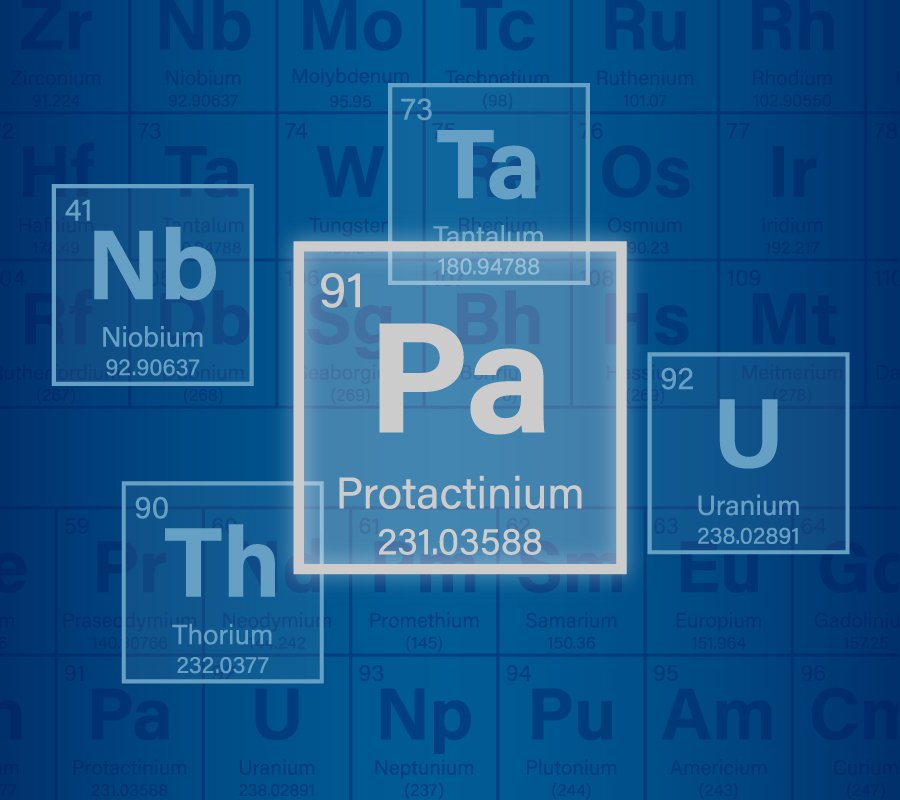Identity.
Protactinium, element 91, is a rare, silvery-gray metal found in trace
amounts within uranium ores. While intensely radioactive and reactive,
it holds mysteries within its fleeting existence. Predicted before its
discovery in 1934, this "first actinium" bridges the gap between its
neighbors, holding unique chemical properties and offering glimpses of
potential beyond its radioactivity. From tracing ancient ocean
currents to hinting at alternative nuclear fuels, the story of
protactinium continues to intrigue scientists and unravel its secrets.
Atomic Structure:
At its core, a protactinium atom holds 91 electrons, arranged in a
complex dance around a nucleus. Imagine 2 electrons closest to the
center, followed by 8, then 18, 32, and 20 more in increasingly
distant shells. The outermost shell boasts 9 electrons, including 2 in
the "f" sub-shell, giving protactinium its unique chemical behavior.
This intricate electronic structure governs how protactinium interacts
with other atoms, forming bonds and exhibiting its diverse properties.
History.
For centuries, protactinium lurked unnoticed, hiding within the decay
chain of uranium. In 1913, Kasimir Fajans and O.H. Göhring stumbled
upon a short-lived radioactive isotope they named "brevium," meaning
"brief." It wasn't until 1917-18 that independent discoveries by Lise
Meitner, Otto Hahn, Frederick Soddy, and John Cranston revealed a
longer-lived isotope and solidified the element's existence. This
newfound element, named protactinium ("before actinium"), filled a
missing gap in the periodic table.
Isolating this elusive element proved challenging. Despite
predictions from Dmitri Mendeleev in 1871, it wasn't until 1934
that Aristid Grosse managed to obtain miniscule amounts of
metallic protactinium. The process was tedious, involving repeated
purification steps and manipulation of protactinium compounds.
This isolation marked a significant milestone, finally allowing
scientists to directly study protactinium's properties.
Despite its rarity and radioactivity, protactinium isn't
completely out of the spotlight. The most stable isotope,
protactinium-231, plays a role in dating ocean sediments and holds
potential for alternative nuclear fuel production. The journey to
understand protactinium continues, from its initial fleeting
glimpses to its present-day applications and future possibilities.
Usage.
Protactinium's limited availability and radioactivity restrict its
everyday uses. However, it offers intriguing glimpses of potential:
dating ancient ocean sediments, holding promise as a future nuclear
fuel, and even showing early hints for targeted cancer therapy. While
research continues to unlock its secrets, protactinium's story extends
beyond its radioactivity, offering glimpses into the fascinating world
of scientific discovery.
-
Ocean Sedinment Dating: The most common use of
protactinium today is in dating ocean sediments. Protactinium-231
(Pa-231) decays at a known rate, and by measuring the ratio of
Pa-231 to its daughter product in sediment layers, scientists can
determine the age of those layers. This helps us understand past
ocean circulation patterns and climate changes.
-
Nuclear Fuel Research: While not currently used in
commercial reactors, protactinium-231 (Pa-231) is being explored
as a potential alternative nuclear fuel source. Through a series
of nuclear reactions, Pa-231 can be converted into fissile
uranium-233, which could offer advantages over traditional
uranium-235 fuel. However, this process is complex and requires
further research before becoming a viable option.
-
Medical Application: Due to its radioactive nature,
protactinium isotopes have been investigated for potential medical
applications, particularly in targeted alpha therapy for treating
certain cancers. However, research is still in its early stages,
and the use of protactinium in medicine currently remains limited.
-
Scientific Research: Beyond specific applications,
protactinium plays a valuable role in fundamental scientific
research. Studying its unique chemical and nuclear properties
helps us understand the behavior of heavy elements and contributes
to our overall understanding of the periodic table and the forces
at play in the nucleus. This knowledge can have broader
implications for various fields, from astrophysics to nuclear
energy development.
Some of the benefits of using Protactinium are:
-
Protactinium-231 acts as a natural clock in ocean sediments. By
measuring its decay, scientists can reconstruct past ocean
currents and understand how climate has changed over millennia.
This knowledge helps us predict future climate trends and manage
our oceans more effectively.
-
Protactinium-231 can be converted into fissile uranium-233 through
complex nuclear reactions. This theoretically offers several
advantages over traditional uranium-235 fuel, like being more
abundant and producing less radioactive waste. However, this
technology is still in its early stages and faces significant
hurdles before becoming a reality.
-
While initial research is promising, certain protactinium isotopes
are being explored for their potential in targeted alpha therapy
for specific cancers. Alpha particles emitted by protactinium are
highly effective at killing cancer cells while minimizing damage
to surrounding healthy tissue. However, much more research is
needed to determine its safety and efficacy.
-
Though not a direct benefit, studying protactinium deepens our
understanding of the periodic table and the behavior of heavy
elements. This knowledge spills over into various fields, like
astrophysics and nuclear energy development, contributing to
technological advancements and our overall understanding of the
universe.
Sources.
While protactinium isn't found in abundance, it isn't a complete ghost
either. Trace amounts reside within uranium ores, specifically
pitchblende. Additionally, it forms as a byproduct in nuclear
reactors, albeit in minuscule quantities. This scarcity highlights the
ingenuity required to study and utilize this fascinating element,
making its scientific journey even more intriguing.
Properties.
Intense Radionactivity: All known protactinium isotopes are
radioactive, with the most stable, Pa-231, boasting a half-life of
around 32,760 years. This radioactivity stems from spontaneous nuclear
decay, emitting alpha, beta, and gamma radiation.
reactive Silver Shine: This dense metal possesses a
silvery-gray luster but readily tarnishes in air due to its reactivity
with oxygen. It interacts with water vapor and inorganic acids,
forming various chemical compounds. Interestingly, its conductivity
changes dramatically at low temperatures, becoming superconductive
below 1.4 Kelvin.
Chemical Versatility: While typically found in the +5 oxidation
state, protactinium can display varying oxidation states like +4, +3,
and even +2 in some solid compounds. This versatility allows it to
form diverse chemical bonds, leading to a range of compounds with
different properties, offering potential for future applications.
